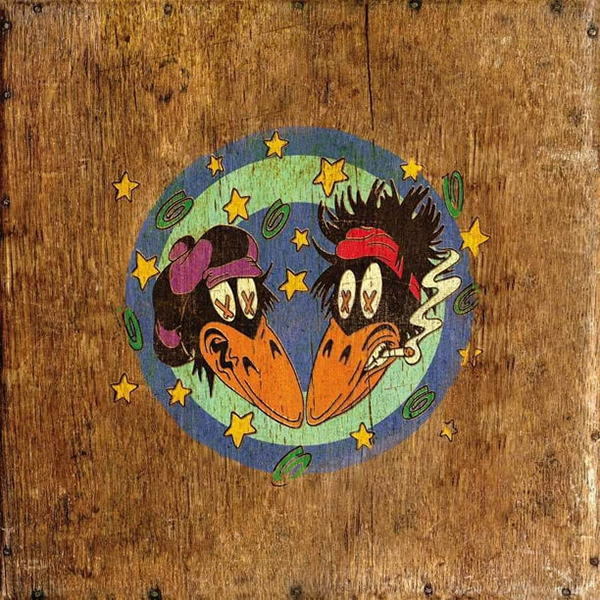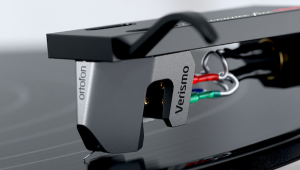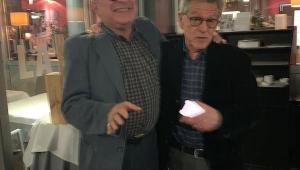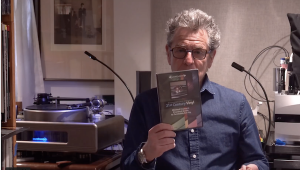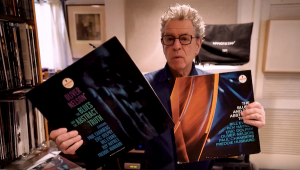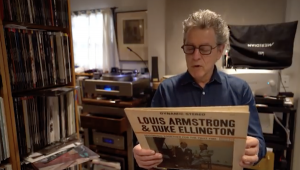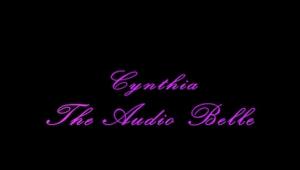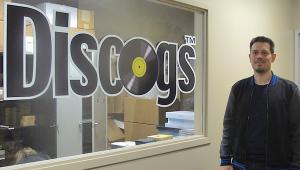The Black Crowes Confirm That Finding the Original Quarter-Inch Master Tapes Inspired How the New 180g 4LP 30th Anniversary Box Set Commemorating Their 1992 Album The Southern Harmony and Musical Companion Was Able to Take Flight on Vinyl
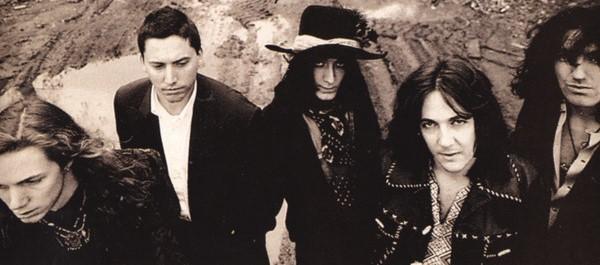
Even though they initially took flight in the burgeoning digital age as the calendar turned to the 1990s, The Black Crowes have always had an analog-centric mindset. For one thing, the down-home rock/soul grooves of their debut album on Def American, February 1990’s Shake Your Money Maker, made that record feel like it could have been released in the mid-’70s — and when the time came to do the inevitable 180g 4LP 30th anniversary box set for it in 2021, The Crowes went all-in by digging out the master tapes to make sure it was done exactly right.
Naturally, it only seems logical for The Black Crowes to have taken a similar approach with what they’ve just put forth for The Southern Harmony and Musical Companion 180g 4LP box set (Def American Recordings/UMe) that was just released last Friday, December 15, in celebration of the 30th anniversary of their 2x-platinum-selling sophomore album that was originally released in May 1992 on Def American.
The Southern Harmony and Musical Companion box set stats are these: guitarist/vocalist Rich Robinson and lead vocalist Chris Robinson, alongside producer George Drakoulias (Tom Petty and The Heartbreakers, The Jayhawks), revisited the band’s archives in order to compile this super deluxe 180g 4LP edition that features a) the original album now remastered from the original ¼-inch production master tapes on LP1; b) 14 unreleased studio recordings and rare B-sides left over from the original December 1991 and January 1992 recording sessions on LP2; and c) 10 live performance tracks culled from Sam Houston Coliseum in Houston, Texas on February 6, 1993 — the latter being quite well-known as a much-bootlegged show now newly mixed from the 24-track tapes — on LP3 and LP4. Standout tracks to my ears include the lost heavyweight gem “99 Pounds” and the rollicking cover of Bob Dylan’s “Rainy Day Women #12 & 35” on LP2, the “well, come on — let’s get funky” break in the middle of “Thorn in My Pride” as well as the “Jam” that precedes that song on LP3, and the pleading desperation of “Sometimes Salvation” on LP4.
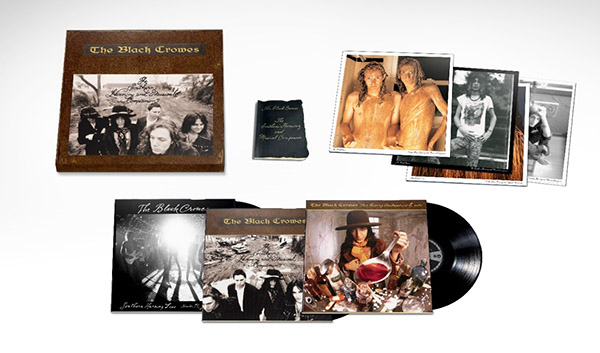
Meanwhile, the physical appearance of the authentic-feeling, weathered-leather-looking Southern Harmony box set itself — quite reminiscent of the literal sepia tone and last-century feel of The Band’s self-titled September 1969 sophomore album — sports a lift-up cover lid for relatively easy interior access. Extras include a reproduction of the original, 132-page promotional hymnal-size book featuring mostly handwritten insights on the record as nestled in an inset slot centered inside the box’s inside-back cover frame, as well as a set of four lithographs of classic band images from the Southern Harmony photo sessions. Now, while I do indeed still have my original promo copy of said hymnal book that I got from the Def American PR team upon the initial album release’s promotional period back in early 1992, I’m more than happy to have a new, pristine version of it, seeing how my original hymnal’s black, textured cover is a good bit worn at this point, including its upper-right rounded corner being all bent and crackled.
According to the last text page in the hymnal book, the Southern Harmony reissue was mastered by Kurt Bradley (a.k.a. KB) for Chris Athens Masters in Austin, Texas. We’re awaiting further direct confirmation on who cut the lacquers and where the LPs were pressed, seeing how the stamped-numbers runout groove info is less than truly enlightening — regardless, these 4LPs all sound just like they should, to my ear.
Finally, the SRP for The Southern Harmony and Musical Companion 4LP box set is $179.99, while the 180g 1LP edition of the core Southern Harmony album by itself is $27.99.
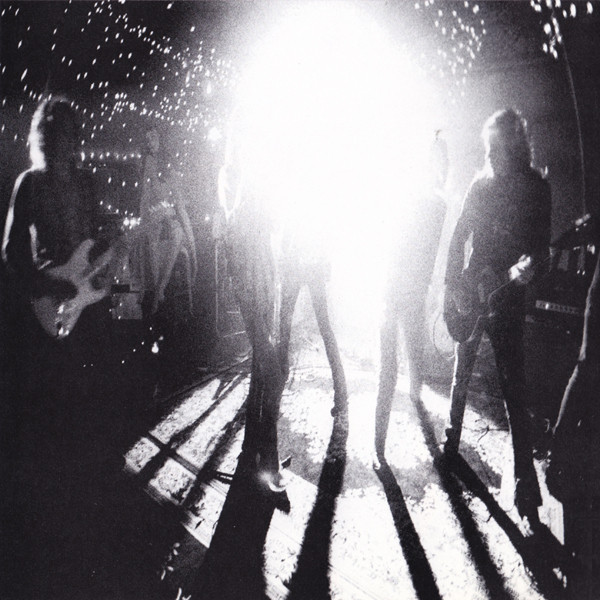
Before speaking with the Brothers Robinson for this story, I went back to prior, separate chats I had with them both to confirm just how analog-driven they are. “The vinyl is part of the culture, and we do have to take greater care and time to make them happen the right way,” Chris told me when we sat down together in New York City in late July 2016. “People laughed at me for listening to records in the mid-’90s at my house in Laurel Canyon, but I’ve always done it that way.” Chris added that The Crowes took great care to meet their fanbase’s needs by doing things like white vinyl for the 1LP version of November 1994’s Amorica on American Recordings, not to mention the translucent-green and opaque-white 2LP color combo for their most recent studio album, September 2009’s Before the Frost. . . Until the Freeze, which was issued on their own Silver Arrow imprint.
As for brother Rich, “Vinyl is more of a process. It’s not convenient, but people seem to have more respect for it,” as he related to me by phone in May 2017. “You have to interact with it, and we have a lot more respect for something we have to work for. There’s a tactile response to it. There’s a smell, and you listen to it. It can be glorious — and you have to listen vigilantly, because it doesn’t last very long. You have to get up and change it. The other thing is, if you own a record, you own a record — and you can listen to it anytime you want.”
Rich concluded his thought process here with something we can all connect with. “Listening to vinyl actually makes sense, because I think this is real music people can touch on and relate to — and it’s more important now than ever,” he summarized. “It’s important to show and elicit true and authentic feelings.” And if there’s any album in The Black Crowes’ storied catalog that wears its feelings on its inner sleeve, The Southern Harmony and Musician Companion surely fits that authentic bill to a down-south jukin’ T.
The Brothers Robinson, along with producer Drakoulias, and I all got on Zoom together recently to discuss how finding the original quarter-inch master unlocked the Southern Harmony vinyl collection, the vintage turntables both brothers swear by, and why sequencing the album for vinyl playback was always of primary consideration. All I want is a remedy / For all of the things that I need. . .
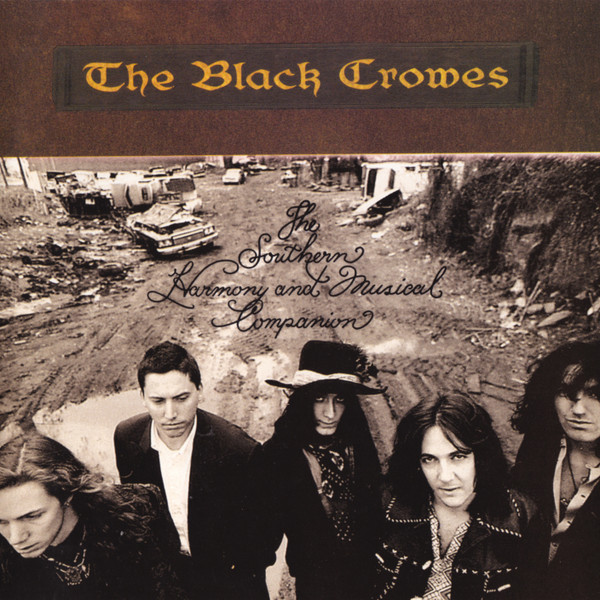
Mike Mettler: Let’s start with you, George. Were you the one to find the ¼-inch masters for this box set? Where did they come from?
George Drakoulias: Yeah, I found them. They were all in storage, yes.
Chris Robinson: (nods) They were in the vault.
George: That’s right — they were in the vault. They were not lost.
Mettler: I’m glad to hear that, because I remember the 2LP version of Southern Harmony that came out in 2015 [on American Recordings], but I figure you didn’t use the masters you found for this new edition for that older one, right? Is this the first time you’ve gone back to the original ¼-inch tapes?
George: Yeah. We went back to the original source masters for this edition.
Mettler: Did you find that that, to your ears, the new Southern Harmony LP sounds better in terms of the detail? Because for me, as a listener, hearing things like some of the percussion elements on “Remedy” [Side One, Track 2] that were kind of buried a little bit digitally, seem to come out better on the new vinyl. Would you guys agree with that?
Rich Robinson: Thirty-seven percent better, yes. (all laugh)
Mettler: (laughs) Good to know — and we’re gonna measure that, by the way. We can put that LP in the lab, and measure it directly to get the exact percentage.
George: (smiling) Find the microcosm of it all, yeah. Go for it. (more laughter)
Mettler: Did you guys listen to any test pressings to do some QC for the box set?
George: I heard the acetates, yeah, and they sounded good. And acetates, as you know — they also smell good too, kind of like a bowling ball.
Chris: Oh yeah? Good for the first few sniffs?
George: Yeah, “give me some acetate.” (more laughter) Eau de bowling ball.
Rich: It’s on the scratch ’n’ sniff pad that’s inside of the album.
Mettler: I’m all for that. Now, do you guys feel the Southern Harmony record is better served in its new vinyl edition than it ever was digitally? What makes it better in its analog listening form for you guys as the artists?
Rich: I think in the nature of what it was — in terms of how it was conceived, and how it was recorded — it just sounds that way. It’s an analog record. I mean, that’s how we always approached it, so this new version, to me, captures more of that element than it did on CD. I like it better split into an A-side and a B-side.
Chris: Yeah, and at the time we recorded it, we were in the final stages of the way the whole machine — the business — was still focused before CDs just overran everything. We were way closer to that analog style of recording than we are today making new recordings, you know?
George: (nodding) Back then, you were closer to The Beatles recording 4-track than you are to what happens today, yeah. The amount of stuff people do today, and how they record — it’s crazy.
Mettler: To me, Southern Harmony has more of a Music From Big Pink vibe to it where everybody is just kind of grooving and vibing together in how the music comes across. Would that be fair to say? [Music From Big Pink, The Band’s seminal debut album, was released on Capitol in July 1968.]
Rich: Yep!
Chris: Yeah — and it’s funny you say that. Like, on “Bad Luck Blue Eyes Goodbye” [Side One, Track 4], the first lines of the song are, “With my winter time / My idols and stage fright” — and the words “stage fright” are a reference to The Band. [Stage Fright, The Band’s third studio album, was released on Capitol in August 1970.]

And that record, Stage Fright — at least, lyrically — was really influential on me at that moment. The first Little Feat record was another one like that, more so than any other Little Feat record was, at that time. [Little Feat’s self-titled debut album was released on Warner Bros. in January 1971.]
But also, like I get with lots of like reggae music and lots of funk and soul, I also had that kind of thing of feeling free. And this record [Southern Harmony] has a lot of all of that, especially when we talk about looking back at what makes it different from other rock records that came out then — and different, I even think, to today. Except for bands that maybe were kind of copping some Sabbath-y things — and we don’t play riffs like [Black] Sabbath — but we were doing mid-tempo, [mouths the beat] boom-tih, boom, boom, boom-tih — that mid-tempo kind of groove things that other rock bands really wouldn’t do back then.
Mettler: Yeah, that’s a great point. Well, I gotta say, Southern Harmony is also a perfectly sequenced record. When you guys were making it, was coming up with that particular sequencing crucial? Even back in the digital age, was it like, “We want this to feel like a two-sided record”? When you actually drop the needle on the main album, it really feels like you had that in mind.
Chris: We’ve approached every record like that. We still have that mentality of having the feeling of flipping over a record, even when it was primarily a CD world. We still, in the process of making it, had to look at records in terms of the storytelling of the record of coming across in that way. That’s never changed.
Mettler: Was there anything you felt was out of sequence when you were first working on this album, and you had to move the tracks around when you got to that point? Or did you guys just kind of feel like, “Hey, ‘Sting Me’ has gotta start this record off — there’s no question about it.”
Rich, Chris, and George: (all three in unison) Yeah.
Chris: By the time you’re into making the record and listening back to the record, you’re involved with it every day, and. . .
Rich: (interjects) It becomes second nature. You almost don’t have to think about it.
Chris: Yeah. It just shows itself.
Mettler: Can you guys think of any other perfectly sequenced records in your own listening experiences? As in, “Artist X’s record is the best, drop-the-needle listening experience”?
Chris: (no hesitation) Exile on Main St.’s pretty good. [Exile is, of course, The Rolling Stones’ iconic May 1972 release, on their own Rolling Stones Records imprint.]
George: Oh, yeah!
Chris: Sticky Fingers may be even better. Physical Graffiti. If You Want Blood. (laughs) Yeah. [The Rolling Stones’ Sticky Fingers was released in April 1971 on Rolling Stones Records, Led Zeppelin’s Physical Graffiti was released in February 1975 on Swan Song, and AC/DC’s If You Want Blood You’ve Got It was released in October 1978 on Albert/Atlantic.]
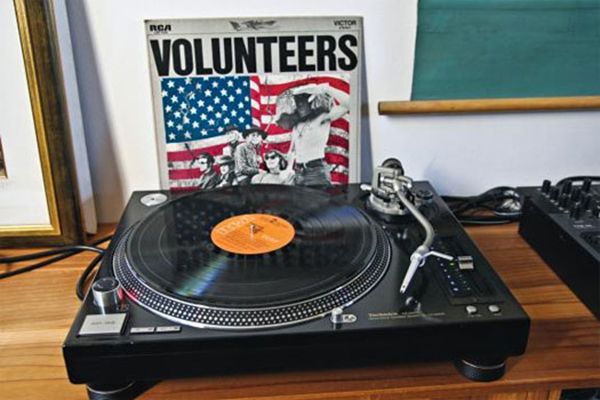
Mettler: Those are all great choices, I totally agree. Let’s talk turntables now. What turntables do you have currently? Chris, the last time we talked about it [in 2016], you had some of those cool vintage Technics ’tables, the SL-1210M5Gs.
Chris: Yeah, I still have the same ones. That’s too many [model] numbers to remember, but yeah, that’s the one. (laughs)
Mettler: (chuckles) Fair enough. Rich, what kind of turntables do you have?
Rich: I have SL-1200s — you know, the old-school Technics. That’s what I have, from like forever ago.
Chris: Actually, I have even more vintage ones that I got recently from my stereo guy, now that I think about it.
Rich: They’re bringing them all back, right?
Mettler: Oh yeah, yeah. I recently wrote a story about how two of the Technics 1200s were being updated as the SL-1200GR and SL-1210GR.
Chris: Cool. Not only do they sound good, they just work. They’re indestructible.
Mettler: They sure are. George, what did you grow up with? What was the turntable you had as a kid?
George: As a kid, we had something like a Kenwood, just to start with. On Long Island, we would go to Crazy Eddie’s, and just get whatever we could afford. [The now defunct Crazy Eddie was a legendary, if troubled, consumer electronics chain founded in Brooklyn in 1971, and one of their cult-favorite TV commercial slogans was, “our prices are insane!”] But we did have a quad stereo for a minute.
Chris: You’re like, “I don’t need to listen to [’70s British pub rocker] Wreckless Eric on quad.” (George laughs)
George: (laughs) I also had an 8-track, and then I figured out a way to record to the 8-track, which is kind of cool.
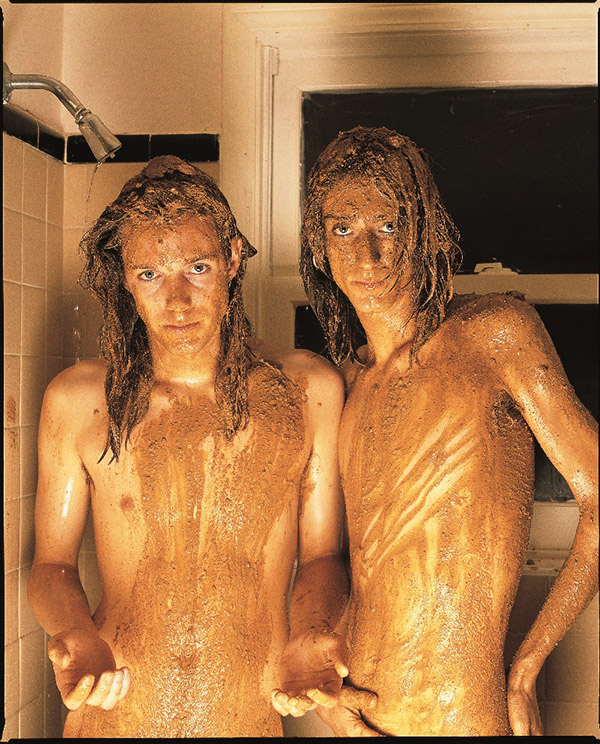
Mettler: It sure is. Now, Rich and Chris, did you guys fight over records growing up, or did you share nice?
Chris: Ummm. . .
Rich: (interjects) No, we never fought.
Chris: No. I mean, I always had more records. Like, I was the guy who bought records. We only had one stereo between us, in my room. Mom and Dad, though — there was one downstairs, but if I [got out of line], the punishment for me would be to take the record player out of my room, which was like the dumbest f---ing thing in the world! (laughs)
And then there was a time in the early ’80s when your Dad comes to your room and you’re listening to the Circle Jerks’ [July 1983 LP] Golden Shower of Hits, and he’d be like, “What the f--- are you doing? Why are you listening to this?” (laughs again)
Mettler: He was probably like, “Your door has to stay open from now on. You’re not allowed to close the door anymore.” (more laughter) Now, if I remember the story correctly, Chris, you once told me that, when you were a kid, you and your parents went to a record shop in Greenwich Village and the first record you ever bought was an Easybeats record. Do I have that right?
Chris: Yeah. I was a teen, but it was a best-of The Easybeats on white vinyl called Absolute Anthology [1965 to 1969] [a 3LP set of the Australian garage rockers better-known tracks that was released in 1986 on Impact, a German label].
Mettler: Do you still have that record? You must.
Chris: You know what? I don’t know if I have that record anymore. I had English bulldogs in the early ’90s, and they ate like a whole bottom shelf of my record collection! One of the records I had kept was by the band Opal, with [guitarist] David Roback and [bassist] Kendra Smith. They made an EP on One Big Guitar [1985’s Northern Line], and I still have it, but the cover is chewed off. The vinyl’s fine but, yeah — they ate a bunch of my records.
Mettler: Oh, man, I’m sorry to hear that! Now, Rich, what would you say for you was the first record that was your own — the one that you didn’t share, the one that was like your thing you didn’t have to share with Chris or anybody else?
Rich: (slight pause) I don’t know. That’s a good question. Chris, he would go out into the world, and I didn’t really want to go out into the world too much — but he would go into the world and buy records. And then I would sneak them a little bit and play them, and pick the ones that really moved me musically, from a feeling standpoint.
Chris: (looks at Rich) When we were kids, we both loved Jimi Hendrix’s greatest hits — the Smash Hits record [released in April 1968 on Track].
Rich: Yeah, I love Jimi Hendrix.
Chris: Yeah. And we had that David Bowie hits record —
Rich: Changesonebowie [released in May 1976 on RCA], yeah. And then AC/DC, If You Want Blood You’ve Got It [as noted earlier, released in October 1978 on Albert/Atlantic].
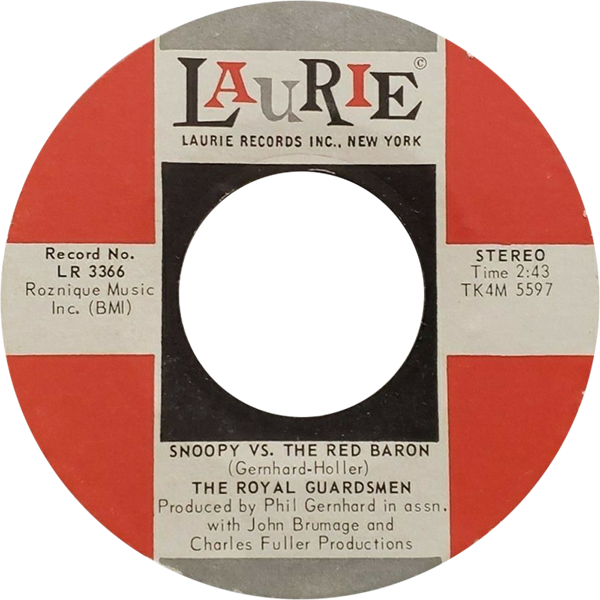
Mettler: George, what about you? What was the first record you had when you were growing up on Long Island?
George: Yeah, it was The Royal Guardsmen, “Snoopy vs. the Red Baron,” on Laurie Records [released as a 45 in November 1966]. It was all 45s in the beginning, when I was really young — like The Cowsills’ “Hair” on MGM Records, with the lion on the logo [released as a 45 in March 1969].
I had an older brother, so I get some of his hand-me-downs, but I think the first album I got myself was probably something like Foghat (chuckles) — the Live one, with “Slow Ride” on it [released in August 1977 on Bearsville]. That was my first album album. And then I saw Foghat and Sweet at the Nassau Veterans Memorial Coliseum [in Uniondale, New York, on June 2, 1978].
Mettler: I bet that was a great show. Based on what I’ve heard on the second LP in the Southern Harmony box set with all the B-sides and covers like [Bob] Dylan’s “Rainy Day Women #12 & 35” [LP2, Side One, Track 3], it sounds to me like you guys were in a real groove on that day. Everything just seemed to click.
Chris: Yeah, most definitely! I mean, one of the reasons I think music appeals to people like Rich and I — and George too — is, we’re not 9 to 5 people, you know what I mean? We’re not neurotypical. We’re not. I think the one thing about music that is always the biggest gift of music — and the reason a lot of musicians are the way we are — is that’s the only thing in life that makes sense to us. It’s the only place that we’re not swimming upstream, or that we’re not dealing with the other powers in life. Life is adversity — and struggle, as well — but playing music is the one thing I have that is the answer to all that, you know? (laughs) And it’s not an ego thing at all. It’s not about being better or worse. It’s not. It has nothing to do with an egocentric attitude. It just has to do with the reality of life.
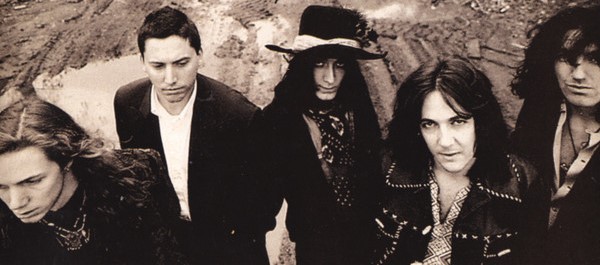
Mettler: Well, hey — music is life, as the saying goes. Anyway, I know we’ve gotta wrap this up, so I want everybody to answer this last question in their own way. I’m gonna jump us like 50 years into future, so it’s 2073. Unless, as I like to say, there’s some weird science going on, we’re probably not physically on the planet in that year. Maybe we are, maybe we aren’t. (all laugh) But whatever listening device people have in those years ahead, and they type in “The Black Crowes” and “Southern Harmony” into their listening thing, what do you want somebody 50 years from now to get out of listening to this record?
Chris: The same thing I get out of listening to records. I want them to just have a soulful connection. It may be part something in the imagination, or it will be something soothing in an emotional place to realize you’re not alone. Like I said, we might not be neurotypical, but that’s what connects all of the freaky, weird people. And you know what? The squares — they’re allowed to feel too! (laughs heartily)
I want people to have a connection on a level that — you know, I’m the same. I put on songs when I’m melancholy, I put on songs when I want to get pumped for the gig, and I put on songs when people are at the house. There are too many reasons of what that feeling is, and I get it from listening to music.
But it’s funny. As you get older — and I’m about to be 57 in December [on December 20, in fact!] — there are still a lot of times you meet someone new and you’re like, “Well, what records do you have in that pile? What records do you have in your house? What have you been buying?” And that dictates a lot of how you get along. (chuckles)
Mettler: Yeah, that’s true. Those albums are your connection point. George, what would your answer be? What do you want people to get from this music 50 years from now?
George: I think I want them to feel inspired. Inspired to do what they want to do; inspired if it changed their day. Like Chris was saying, I want to have it put you in a different kind of mood and give you the strength to do something, or get through something — or just, you know, have a celebration. I want them to recognize that these guys [points to Chris and Rich] were here, and they did this music for you.
Mettler: They sure did. Rich, what do you say? What’s your take on that?
Rich: I want them to get more of the organic, human nature of a music that wasn’t bogged down with “mechanicism.” And I mean it in the sense that, if they’re in a time where A.I. has kind of sucked all the humanity out of music — I mean, A.I. is great (laughs), but music is a breathing thing. There’s a humanistic part in it. What I love about it is the ebb and the flow of it, and how there are actually no mistakes. That perfection is the human experience, and the human expression.
George: Yeah — 50 years from now, you can sit down and be able to have a conversation with these guys, even though they’re gone. Their music lives on.

THE BLACK CROWES
THE SOUTHERN HARMONY AND MUSICAL COMPANION
180g 4LP (American Recordings/UMe)
LP1 – The Southern Harmony and Musical Companion
Side One
1. Sting Me
2. Remedy
3. Thorn In My Pride
4. Bad Luck Blue Eyes Goodbye
5. Sometimes Salvation
Side Two
1. Hotel Illness
2. Black Moon Creeping
3. No Speak No Slave
4. My Morning Song
5. Time Will Tell
LP2 – More Companions: Unreleased, Outtakes, and B-Sides
Side One
1. 99 Pounds
2. Miserable
3. Rainy Day Women No. 12 & 35
4. Boomer’s Story
5. Darling Of The Underground Press
Side Two
1. Sting Me (Slow)
2. Bad Luck Blue Eyes Goodbye
3. Sometimes Salvation
4. Black Moon Creeping
LP3 – Southern Harmony Live: February 6, 1993 (Houston, TX)
Side One
1. No Speak No Slave
2. Sting Me
3. My Morning Song
Side Two
1. Jam
2. Thorn In My Pride
LP4 – Southern Harmony Live (continued): February 6, 1993 (Houston, TX)
Side Three
1. Bad Luck Blue Eyes Goodbye
2. Black Moon Creeping
3. Hotel Illness
Side Four
1. Sometimes Salvation
2. Remedy

THE BLACK CROWES
THE SOUTHERN HARMONY AND MUSICAL COMPANION
180g 1LP (American Recordings/UMe)
Side One
1. Sting Me
2. Remedy
3. Thorn In My Pride
4. Bad Luck Blue Eyes Goodbye
5. Sometimes Salvation
Side Two
1. Hotel Illness
2. Black Moon Creeping
3. No Speak No Slave
4. My Morning Song
5. Time Will Tell
